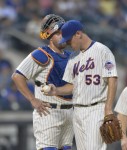Jeremy Hefner
The first ever pitcher to be used in a doubleheader after Major League Baseball’s inception of the 26th Man Rule was former Met Jeremy Hefner. On April 23, 2012, Hefner would make his big league debut pitching three scoreless innings in the first game of the doubleheader. Since that point, Hefner would need not one but two Tommy John surgeries. After the second surgery, the Mets would not offer him a contract making a free agent. Currently, he is pitching for the Cardinals’ AAA affiliate the Memphis Redbirds. His story might have began as one of a statistical oddity to one of perseverance.
With that in mind, it is fitting that Josh Smoker was called-up by the Mets to be the 26th man for the second game of the doubleheader against the Cardinals last night.
Smoker had originally been a first round pick by the Washington National back in 2007. However, Smoker would never make it past A ball. There was the first surgery in 2008 to remove bone spurs from his pitching shoulder. There would be two more surgeries in 2013 to repair his labrum and rotator cuff. After that, he was released by the Nationals organization leaving him with two options: (1) retire from baseball altogether; or (2) give it one last shot.
His shot would come with the Rockford Aviators of the Independent Aviator Leagues. That Illinois team is located approximately 886 miles away from Citi Field, but in reality, Smoker seemed further away from the big leagues than that. Initially, his three times surgically repaired shoulder didn’t have its velocity leaving him with an unspectacular 1-0 record with a 4.03 ERA and a 1.793 WHIP. However, his velocity would come back, and the Mets would take notice offering him a minor league contract.
Suddenly, Smoker and his fastball that could top out around 98 MPH was blazing through the Mets minor league system. He would start the year in the Sally League, and he would finish the year with AA Binghamton. The pitcher who had trouble getting independent leaguers out had a 3-0 record with a 3.12 ERA and a 1.184 WHIP. Given his prior years of service in the Nationals’ organization, the Mets were forced to decide whether to put Smoker on the 40 man roster or to expose him in the Rule 5 Draft. Not only would the Mets put him on the 40 Man Roster, but they would also allow him to start the year in AAA. Like most pitcher’s in the Pacific Coast League, Smoker’s ERA and WHIP would take a hit. However, what really stood out this season is the fact that Smoker is striking out 13.2 batters per nine innings. With the Mets having an open roster spot, and the team not wanting to tax the bullpen, the Mets had little choice but to add the pitcher who is striking out more batters per nine than anyone in their farm system.
And with that, Smoker has officially made it. He is now a big league pitcher. He persevered through three shoulder surgeries and diminished velocity. He has overcame each and every obstacle thrown his way. He didn’t get in the game, but it doesn’t diminish what he’s accomplished. Given the quirks of the 26th Man Rule, he’s on his way back to AAA. Without a doubt, he will be back with the Mets, and he will pitch in a game next time.
Congratulations Josh Smoker.

Last year, we were all spoiled by Matt Harvey‘s return from Tommy John surgery. Even if it took him almost a full season to find his slider, he pitched well, and he was healthy all year. We forgot that he had major surgery and issues can arise during either the surgery or rehabilitation period.
We forgot about former Mets like Jason Isringhausen, who had three Tommy John surgeries. We forgot about Jeremy Hefner, who was rehabbing from his Tommy John surgery at the same time as Harvey. During his rehab, something went wrong, and he had to have a second Tommy John surgery. Mets released him, and now he’s working his way back to the majors through the Cardinals’ organization. Harvey made us forget about all that could go wrong.
Now, there are reports that Zack Wheeler needed to have minor surgery to remove a stitch that didn’t resolve from his Tommy John surgery. He’s going to need two weeks off to allow the wound to heal. He’s now at least two more weeks further away from pitching in the 2016 season.
It’s a reminder that while we all look forward to Wheeler toeing the rubber again, it’s far from a foregone conclusion that’ll happen. There’s still every possibility that Wheeler could have another setback on his road back. In reality, until further notice, Bartolo Colon is the Mets’ fifth starter. Overall, anything the Mets get from Wheeler this year is an unexpected bonus.
We forgot all of that during Harvey’s 2015 season. We’re now reminded of it again. Let’s all wish Wheeler a speedy recovery and wait for the day that he’s once again pitching for the Mets . . . whenever that might be.

Going into the 2016 season, there is one fear each and every Mets fan has. We dare not speak its name, but that doesn’t change the fact that it’s still present. That fear is that a pitcher will get seriously injured.
Looking at this year’s list of pitchers who could befall the dreaded “Verducci Effect,” Noah Syndergaard headlines that list. If Syndergaard was to suffer a season ending injury requiring Tommy John surgery? it would greatly hinder the Mets chances of winning not only the World Series, but also making it to the postseason. It’s something that not just Mets fans fear, but as Anthony DiComo of MLB.com reports, Syndergaard fears it also:
I’ve thought about it quite a bit. But I trust myself to put my body in the right situations to be able to perform at a healthy level.
The fear is justified. Syndergaard threw 65.2 innings more last year. He throws over 95 MPH more than anyone in the game. He’s working to add the fabled Warthen Slider to his already dominant repertoire. Name a risk factor for UCL years requiring Tommy John surgery. Syndergaard meets most if not all of them.
One risk factor not readily discussed is the team he plays for. Look at the projected Mets rotation when healthy: Matt Harvey, Jacob deGrom, Noah Syndergaard, Steven Matz, and Zack Wheeler. Put aside Syndergaard for a moment. What do the other four have in common? They are all hard throwing pitchers under the age of 30 who have already had Tommy John surgery.
Go outside this group. Since Warthen took over as the Mets pitching coach, the following homegrown Mets have sustained arm injuries: Jon Niese (shoulder), Dillon Gee (shoulder), Jeremy Hefner (two Tommy John surgeries), Rafael Montero (shoulder), Bobby Parnell (Tommy John), Josh Edgin (Tommy John), Jack Leathersich (Tommy John). There are more, but you get the point.
Now, is this an organizational problem since Warthen took over, or is it just bad luck? Could this all have been avoided? Back in the 60’s and 70’s the Mets developed pitchers like Tom Seaver, Jerry Koosman, Nolan Ryan, and Jon Matlack. These pitchers threw more innings than the pitchers today, and yet, Matlack was the only one of this group that suffered an arm injury.
In the 80’s, the Mets had Dwight Gooden, Ron Darling, Sid Fernandez, Rick Aguilera, Randy Myers and David Cone. Of this group, only Doc and Cone had arm issues. It should be noted that Doc had many other issues as well, and Cone’s problem was an aneurysm later in his career.
In the 90’s, Generation K was a bust, and the Mets haven’t developed the caliber of starting pitchers like they have in the past until now. However, this generation seems to befall injuries far more often than their predecessors. Is it organizational? Is it bad luck? Is it preparation? For his part, Harvey wonders what if:
I think now, there are things I could have done better in high school or in college to maybe prevent it. But I don’t know. I’m not saying [Syndergaard] works that much harder than everybody else, because we all work hard. I think as time progresses, guys pay more attention to stretching the shoulder, strengthening the shoulder. If I could go back — I don’t know if this would’ve prevented me from having [surgery], but if I could go back and really do 20 extra minutes of stretching and arm care, you never know what could happen.
That’s the thing. We really don’t know why one guy suffers elbow and shoulder injuries while others don’t. Is it preparation? Is it good genes? Is it just good luck? Much time, energy, and money has been spent on this issue, and yet pitchers still get injured. Pitchers get injured despite teams doing everything in their power to try to prevent it.
It will help Syndergaard being in a clubhouse with players who have had Tommy John surgery. They each will have advice for him on why they suffered the injury and what they could’ve done differently. More importantly, Syndergaard appears to be a hard worker who takes the health of his arm very seriously. There is no doubt he is doing everything he can do to avoid the dreaded Tommy John surgery.
Based on what we’ve seen, if anyone can avoid it, it’s him.
Editor’s Note: this article was first published on metsmerizedonline.com

There are all sorts of pitching prospects. There are pitchers who were uber prospects like Matt Harvey. The question with these prospects is where they’ll slot in the rotation. Then there are prospects like Jeremy Hefner.
The prospects like Hefner aren’t no doubters. You’re not a no doubter when you’re a 5th round draft pick who was twice placed on waivers before pitching one big league inning. Hefner referred to himself as “an average prospect.” Average prospects need to make the best of not only their stuff, but also their chances. Somehow, it’s more satisfying when these guys make it. You want the Hefners of the world to succeed because you want to believe in a player that really is doing everything he can do. It’s what you tell yourself you would do if you had enough talent to get that chance.
Well, Hefner made the most of his chances. He showed the Mets enough in 2012 for him to be in the 2013 rotation (even though he might’ve been a placeholder for Zack Wheeler). As the calendar turned to June, he seemed to figure something out. He went on a stretch of eight straight starts allowing two earned or less. Now what happened next is up for debate. Initially, it was thought he regressed to the mean. The truth may just be he was injured. In August 2013, Hefner had Tommy John surgery.
It’s a crushing blow to a player who just arrived on the scene. It was also crushing to him, but also to the Mets. They lost not only Hefner, but also Harvey to a torn UCL. The two rehabbed together. Seeing Hefner’s promise, the Mets kept him around rather than release him. Then something horrible happened. Hefner was not progressing in his rehab. He needed a second surgery. It definitively ended his Mets career. It put his baseball career into question.
Anytime a player like Hefner suffers a setback like this it’s deflating. Part of what makes sports fun is the out of nowhere stories. Everyone knows Tom Brady’s and Mike Piazza‘s stories. They’re reminders that what you need to succeed in sports, and in life, is hard work and determination. Hefner had those qualities. His mind was willing, but his flesh seemed weak.
Fortunately, that’s not the end of the story. Hefner again worked his tail off. We shouldn’t expect anything else. He started pitching in the Winter Leagues. He pitched well enough to sign a minor league deal with the Cardinals. Normally, I hate the Cardinals and their players. However, I’m making an exception here. The world is a lot better when the Hefners of the world are given a chance to succeed. It’s even better when they do.
I thought the Mets should’ve brought him back. I thought he could’ve filled a need as a spot starter or a bullpen arm. Instead, Hefner is a Cardinal, and I couldn’t be happier for him. I’ll be rooting for him.
Good luck next year Jeremy Hefner.

You have a promising career, and then out of the blue, you get sick. You’re not sure about anything, least of all your job. Your employer gives you time and tells you to come back only when you’re ready.
You recover, but you never completely feel whole. Your doctor says you can go back to work. However, you need to be a little cautious. You can’t let yourself get that sick again. At that point, you go back to work. Your employer welcomes you with open arms. Everything is great.
You’re a workaholic. You always have been. You come back working pretty close to the hours you used to work. Your employer is concerned and wants you to slow down. You only know one way to go, and you continue working harder than you probably should. Your performance has been great. You love being back doing what you love. Initially, your employer takes some stuff off your plate.
Eventually, they realize it’s useless, and they let you be you. Then it happens. It’s not all at once. However, you begin to notice it. While your performance seems like it’s the same, you know it isn’t. You put it off, but you eventually see the doctor. He tells you that you need to scale it back. You’re going to need to take some time off. If you don’t, you can get sick again, or worse. Your career might be over. Your ability to earn a paycheck forever gone.
You tell this to your employer. The problem is there’s a huge deadline coming up. It’s the biggest project they’ve ever taken on, and they need all of their best people on it; that means you. They tell you they can give you some time here and there. However, they’re going to need more from you than you really should give. You talk to your doctor again, and while he can’t offer guarantees, he strongly advises you from pushing it. You tell your employer.
Your employer is now angry. They feel duped. They knew the situation the whole time, but they began to count on you. Earlier they knew you were working harder than you should, but they don’t care anymore because there’s more on the line now. No, you’re not getting fired, but their opinion of you has changed. Your options are now to potentially risk everything and work or to take the time off you most likely need.
Ultimately, do you continue working or do you protect your health? If you honestly would continue working, and I know people that would, you can scream and yell at Matt Harvey. If you take the time off back off of Harvey. If you’re not willing to make the sacrifice, don’t expect someone else to make it.
Personally, I once put off tests and ignored doctor’s advice because I was asked to by my employer. My grandfather was a construction worker who worked year round. My father was injured in Vietnam. He’s a DAV. They never took a day off. Who was I?
I worked in an office. I wasn’t putting together the Verrazano Bridge. I wasn’t wading in rice patties in Vietnam. I worked in an office. I ignored my doctor’s advice and the pleas from my wife. Foolishly, I thought if I change my diet or change the times I was eating, it would work out.
I got through it, I was in severe pain each and every day. There were sleepless nights from the pain and the work. The busy time eventually ended. In exchange for my hard work? I got to be one of the people at one of those fancy, expensive dinners. My sacrifice was never acknowledged. Im probably still not quite right all these years later.
I was lucky to make it through everything without anything getting worse. I think of these times now when we talk about Harvey possibly shutting it down. The Mets don’t have the right to tell him to ignore his doctor’s advice. They surely aren’t offering him any financial incentive to do so.
We forget he was rehabbing with Jeremy Hefner, who had a setback, had a second Tommy John surgery, and was non-tendered by the Mets. He remains unsigned to this day. You see the Mets were willing to pay him so long as he was able to pitch, but once he wasn’t, he was shown the door.
Should the Mets have paid Hefner anyway? No. However, they should keep in mind if they won’t show loyalty to injured players, they can’t expect other players to show them loyalty. Harvey saw this first hand. He realizes he’s one surgery away from being ruined and losing that $100 – $200 million contact we all discuss.
If he shuts it down now, he’s that much closer to collecting it. If he pitches, he risks it all. Go to Atlantic City with all your earnings, go to the roulette wheel, and pick a number. I doubt you’ll do it. It’s not the risk. Why are we now asking Harvey to risk all that money.
Just because Harvey is an athlete, it doesn’t give us or the Mets the right to ask him to do something that could put him in harm’s way. Personally, I hate the timing. I’m disappointed. However, I also acknowledge, things have been getting worse for a while now. The same Harvey that wanted to pitch in 2014 and hated six man rotations now agrees to skipped starts. He leaves games with dehydration and can’t make the initial trip to Miami.
I can’t prove it but something went wrong within the last month or so. I think it scared him. I bet Scott Boras scared him some more. He thought he was invincible, even after the Tommy John surgery. He remembers Hefner. Maybe I’m wrong and he was convince. By his doctors and/or Boras to stick to 180 or otherwise risk potentially $200 million. He could be being greedy.
The thing is we’d never accept less money in our jobs. We’d never gamble away or future ability to earn a living. We wouldn’t put our bodies at risk for our jobs. We need to stop asking athletes to do the very same things we wouldn’t do ourselves.
We need to give Harvey a break and let him figure this out. Remember he still hasn’t ruled out pitching in the postseason. He just wouldn’t talk about it. You want to get angry? Get angry with the Mets for not offering him some financial security to allow Harvey to pitch in October with one less thing on his mind.